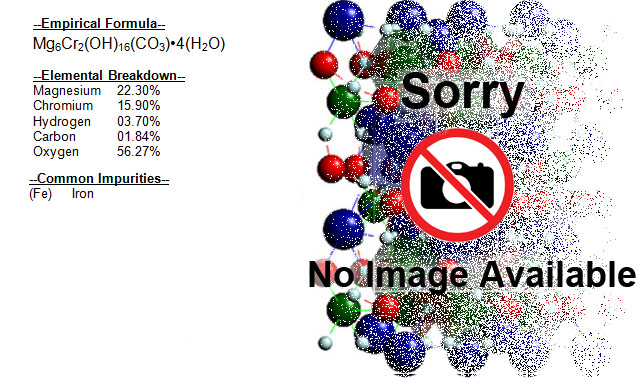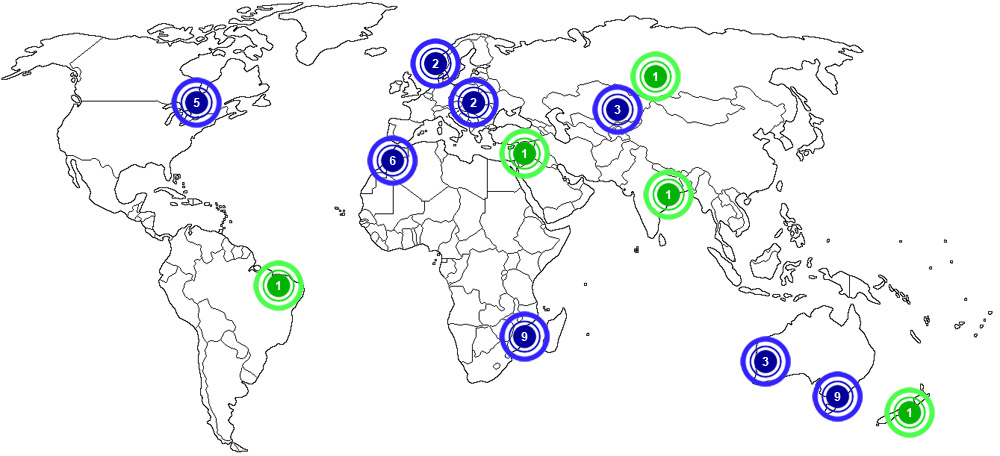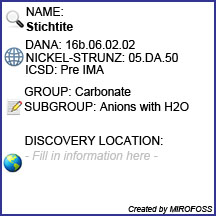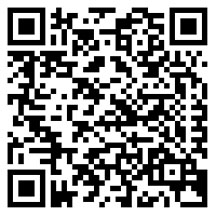

| Mineral Name | Stichtite |
| First Discovered | 1910 |
| Nickel-Strunz Classification | 05.DA.50 |
| Dana Classification | 16b.06.02.02 |
| ICSD | Pre IMA |
| Mineral Group | Carbonates |


| Cleavage | Perfect |
| Colour(s) | Lilac, Light violet, Pink |
| Specific Gravity | 2.20 |
| Diaphaneity | Translucent to Opaque |
| Fracture | Uneven - Flat surfaces (not cleavage) fractured in an uneven payyern |
| Mohs Hardness | 1.5 to 2.0 |
| Luminescence | Non-fluorescent |
| Lustre | Vitreous |
| Streak | Pale violet blue |
| Habit(s) | Encustations to Nodular to Micaceous |
| Radioactivity | Non-radioactive |
| Magnetism | Non-magnetic |

No known health risks have been associated with stichtite. However ingestion of stichtite, as with other naturally occurring minerals, is not recommended.

The following image shows the Elemental breakdown of the mineral stichtite along with the mineral crystal structure.


| Crystal System | Trigonal |  |
| Class | Rhombohedral | |
| Axial Ratios | a : b : c = 1 : N/A : 7.50485 | |
| Morphology | Matted or contorted aggregates of plates or fibres. | |
| Optical Data Type | Uniaxial (+) | |
| Dichroism (e) | Colourless | |
| Dichroism (w) | Colourless | |
| Pleochroism | Weak | |
| RL Values | nω = 1.516 nε = 1.542 |  |
| 2V | N/A | |
| Max Birefringence | δ = 0.026 (See colour chart at right) | |
| Surface Relief | Low | |
| Dispersion | N/A |

Stichtite can be referenced in certain current and historical texts under the one name:
The mineral stichtite can be translated into the following select languages:
| Arabic | Bulgarian | Chinese (Sim) | |||
| Croatian | Czech | Danish | |||
| Dutch | stichtiet | Esperanto | Estonian | ||
| Finnish | French | German | Stichtit | ||
| Greek | Hebrew | Hungarian | |||
| Italian | Japanese | Korean | |||
| Latin | Lithuanian | Norwegian | |||
| Persian | Polish | stichtyt | Portuguese | ||
| Romanian | Russian | Slovak | |||
| Spanish | Stichtita | Swedish | Tagalog | ||
| Turkish | Ukrainian | Vietnamese |

Stichtite can be found in a few places around the world. The map below shows major documented concentrations of stichtite:



 |
The MIROFOSS database offers free printable geological identification tags for personal and non-profit use. These tags can be used to properly identify mineral samples in your collection. -Click here- to download a full size jpeg image for a stichtite identification tag; which can be printed on paper or used with a plastic laser printer. |
 |
What's this? What can I do with it? |

| Chemical Composition | Ashwal, L.D., and Cairncross, B. (1997): Mineralogy and origin of stichtite in chromite-bearing serpentinites. Contributions to Mineralogy and Petrology 127, 75-86. |
| Crystallography | Mills, S. J., Whitfield, P. S., Wilson, S. A., Woodhouse, J. A., Dipple, G. M., Raudsepp, M. & Francis, C. A. (2011) The crystal structure of stitchtite, re-examination of barbertonite and the nature of polytypism in MgCr hydrotalcites. American Mineralogist, 96(1), 179–187. |
| History | Palache, Charles, Harry Berman & Clifford Frondel (1944), The System of Mineralogy of James Dwight Dana and Edward Salisbury Dana Yale University 1837-1892, Volume I: Elements, Sulfides, Sulfosalts, Oxides. John Wiley and Sons, Inc., New York. 7th edition, revised and enlarged: 655-656. |
| Geograpcial Data | Mindat.org. Retrieved on 2012-02-21 |
| Physical Identification | Webmineral.com. Retrieved on 2012-02-21. |
| October 05, 2013 | The last time this page was updated |
| ©2017 MIROFOSS™ Foundation | |
 |